

Fundraising Detective. I've been catching up with some reading in the last month or so and wanted to share short reviews of four books that I believe will help you be a better fundraiser.
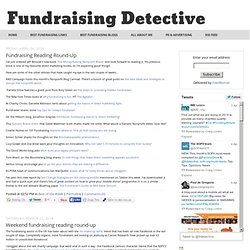
If you've read any of them then do let me know what you thought or if you've got any other reading recommendations, then please share them in the comments. Note: The titles all link to the author's blog or website and there is a US and UK Amazon link as well. Future Fundraising Now. Rebecca Davies. Today’s post is a morsel.
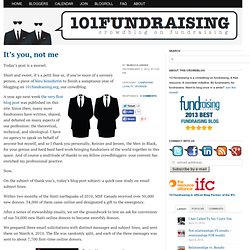
Short and sweet, it’s a petit four or, if you’re more of a savoury person, a piece of bleu bénédictin to finish a sumptuous year of blogging on 101fundraising.org, our crowdblog. A year ago next week the very first blog post was published on this site. Since then, many more fundraisers have written, shared, and debated on many aspects of our profession: the theoretical, technical, and ideological. I have no agency to speak on behalf of anyone but myself, and so I thank you personally, Reinier and Jeroen, the Men in Black, for your genius and hard hard hard work bringing fundraisers of the world together in this space.
Best Practice in Action: Getting creative with your fundraising ideas. Our “Best Practices in Action” series highlights fundraising tips nonprofit organizations can share with their own supporters.
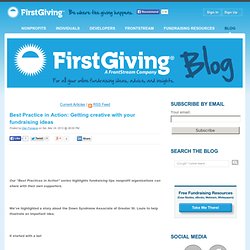
We’ve highlighted a story about the Down Syndrome Associate of Greater St. Louis to help illustrate an important idea. It started with a bet Sometimes the best fundraising strategy is creativity. We learned this first hand back in 2010, when our friends at Down Syndrome Association of Greater St. . $10,000 in four days! Not only did they raise the $10,000 in four days, Jeff’s team raised a total of $16,000 as a result of the videos! Three Classic Fundraising Images from SOFII - Fundraising Detective.
This month's Non-Profit blog carnival (hosted by Katya Andresen) is all about how you can use imagery to improve your storytelling and fundraising.
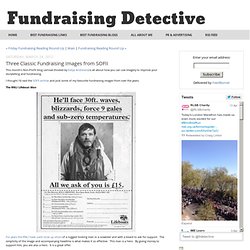
I thought I'd raid the SOFII archive and pick some of my favourite fundraising images from over the years. The RNLI Lifeboat Man For years the RNLI have used close up shots of a rugged looking man in a sowester and with a beard to ask for support. The simplicity of the image and accompanying headline is what makes it so effective. 12 Elements of a Great Online Fundraising Campaign. 1.
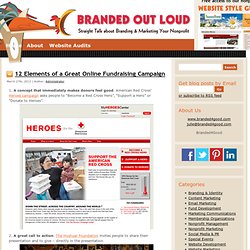
A concept that immediately makes donors feel good. American Red Cross’ Heroes campaign asks people to “Become a Red Cross Hero”, “Support a Hero” or “Donate to Heroes”. Don’t Forget Your $1,000 Gifts. Segmenting your audience – Different communication for different people. The tone you use with your grandmother is, and should be, different than the one you use with your college pals or boss.
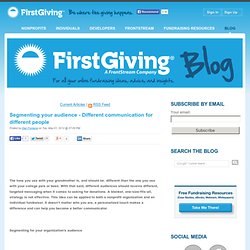
With that said, different audiences should receive different, targeted messaging when it comes to asking for donations. A blanket, one-size-fits-all, strategy is not effective. This idea can be applied to both a nonprofit organization and an individual fundraiser. It doesn’t matter who you are, a personalized touch makes a difference and can help you become a better communicator. TheFundraisingFunnel.com. Early in the year, I received a thank you call from an organisation where I give one-off gifts, as well as a monthly regular gift.
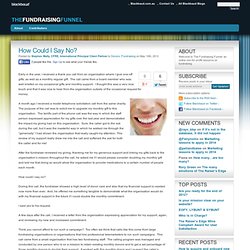
The call came from a board member who was well briefed on my occasional gifts and monthly support. I thought this was a very nice touch and that it was nice to hear from the organisation outside of the occasional request for money. A month ago I received a model telephone solicitation call from the same charity. Duals Asks « The Annual Giving Network. Two truths you should be telling. Tue, May 29 2012 Filed under: Marketing essentials •
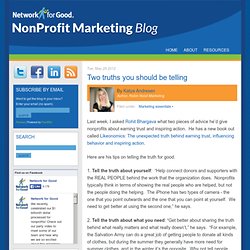
Why donors don't want to hear from you - queer ideas. A report has just been published that adds to the growing body of evidence that shows many charities are still getting something wrong when it comes to donor communications.
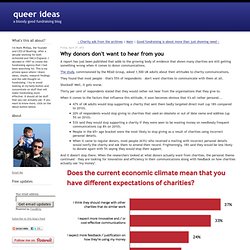
The study, commissioned by the REaD Group, asked 1,500 UK adults about their attitudes to charity communications. The Death of the Unrestricted Gift. Posted by Brendan Kinney Moderator of #fundchat.
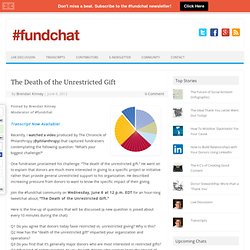
Forget Apps: Young Donors View Web Sites on Smartphones - Marketing and Communications. By Cody Switzer To reach people in their 20s and early 30s, the most important thing nonprofits can do is to make sure their Web sites are easy to read on a mobile device and not overly cluttered, says a survey of more than 6,500 young people released today. About 65 percent of respondents said they liked to learn about a nonprofit through its Web site, compared with 55 percent who said they turned to social networks, e-mail newsletters (47 percent), print (18 percent), and face-to-face conversations (17 percent).
When young adults turn to a Web site, the “about us” section draws their attention most. Nearly nine in 10 young people said that’s where they go to seek information, according to the survey, conducted by two consulting companies, Achieve and Johnson, Grossnickle, and Associates. Good Works Co. - Your most important meeting is with yourself. The Fundraising Collective: Excuse me, can I ask you a question? Fired-Up Fundraising: 20 Best Practices for Monthly Giving Programs. Do you want a fundraising strategy that creates ongoing predictable cash flow? Targeting Those Who Visit Without a Donation.
There's more data about your donors floating around than ever before. To leverage this information, marketers are increasingly relying on this information to 'micro-target' their appeals. Unfortunately, this level of detail is beyond the reach of most nonprofits. Instead, organizations will normally broadcast their message to those who have indicated a previous interest whether through advocacy, email lists, event attendance, or that most hallowed of all people - the lapsed donor; who will come up in your LYBNT and SYBNT reports. Best Practices: Using Video To Promote Your Nonprofit. Odd but true findings? Upgrading annual donors are “erratic” and “volatile” « CoolData blog.
Hazlehurst's Blog » Read ‘em and weep: Obama’s effective email fundraising strategy. Is the Obama campaign the most effective, sophisticated and powerful Internet-based money machine in history? Return to old-style fundraising. Winnipeg Free Press - PRINT EDITION. Big Data is a pipe dream. A 2-step fundraising letter audit. With Thanksgiving sixteen days away here in the USA, it's a great time to do a quick 2-step gratitude check. Pull out your most recent fundraising letter. SickKids - You Got It. Small charities lead the way when it comes to online donations. 8 tactics for integrated fundraising success. It's no secret that technology has changed the way we communicate.
For charities, that means that donors and prospects of all ages are interacting with many types of media as they write cheques, read email and tweet. The Art of the Ask: Nonprofits must be mindful of audience’s desires. Seven Ways to Increase Your Nonprofit’s Donations in 2013. Nearly $7-Million Raised in One-Day Online Contest - Prospecting. Columbia University raised $6.9-million, most of it online and in 24 hours, by running a contest to see which of its 16 schools could produce the most money for the institution’s annual fund. Giving Day, held in October, was the brainchild of CloEve Demmer, director of Columbia’s annual fund. Why Do You Treat Me Like You Don’t Care? – Grizzard Communications Group.
I don’t usually rant in my blog posts, but I hope someone can help me understand something. For the past six months, the chatter in articles, blog posts and tweets has been about the importance of retention. 5 Resolutions to Amplify Your Nonprofit’s 2013 Fundraising Strategy. Plot Your Course for 2013 Leadership and Major Gift Success. Best 6 charity marketing campaigns from 2012 and announcing GBM’s new Shortcut series « Green Banana Marketing. Live Discussion. The Fundraising Collective: How to analyse your appeal letter. $ Make Money $